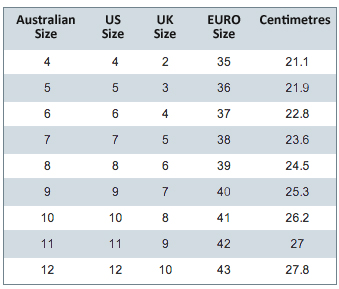
As podiatrists and high-heel experts, we are often advising our clients on how to make sure a shoe is the right fit for their foot. There is a misconception that if you are a size 8, then all sizes 8s will fit you. Unfortunately shoe sizing is not quite that simple. Depending on where the shoe is manufactured, sizing of shoes differs. This can make buying online a little more difficult… So how to get around this?

First – where did shoe sizing come from and why does it differ around the world?
The history of early shoe sizing originated in the Roman civilisation, where shoemakers of that time used ‘barleycorn’ to measure feet when making sandals. In 1324, King Edward signed a royal degree declaring the barleycorn system the official means of measuring shoe sizes. He established that 3 barleycorns equalled an inch. I’m not sure how accurate this was however this system is still in place today in England and Ireland. For example a 39 barleycorn equates to a men’s size 13.
In some parts of France, Germany, Spain and Italy they use a ‘Paris points’ system which equates to ⅔ centimeter. There is also the European ‘Mondopoint system’, which is measured in millimeters and based on mean foot length and width. This is a more precise method of measuring and is used in ski boots and military footwear.
Asian countries use metric and then add 5mm increase for every size and width. Today in the US and Australia most shoe shops use a ‘Brannock device’, which measures length and width and then converts the measurement into a shoe size. The US adds one to UK sizing so a size 9 in the UK equates to a US 10.
So you see with all these different means of measuring, a size 8 in the US, UK or Asia may not necessarily be the same size. It is also important to note that every shoe brand has their own lasts to construct shoes, and these lasts differ from brand to brand which alters the width, length and overall fit of the shoe.
Confused yet? We use this chart for easy reference (save it to your desktop!) –

So how to be sure to get the right fit? Here are some steps we find most useful:
- Where possible, physically try shoes on in the same brand you are considering buying online. If you can try the exact style at your local shops – great, otherwise even trying a different style will give you a good feel of the brand’s sizing
- Try shoes on at the end of the day to ensure they can accommodate any fluctuations in the size of your feet which may swell slightly after a long day standing
- Wear your new shoes around the house and on carpet for 30 mins – 1 hour (where the soles won’t get worn) so you can test how they feel
- Ensure the shop your buying from has a reasonable returns policy to allow for an exchange or refund if you are unhappy with your purchase or sizing
- If you absolutely cannot try on the shoes or brand first, consult the site or brand’s sizing guide – most good online shops will have one

Good luck and happy shopping!
E&E
Ps. Keep an eye out – on Thursday we’ll be unboxing and reviewing a pair of recently purchased designer heels!


